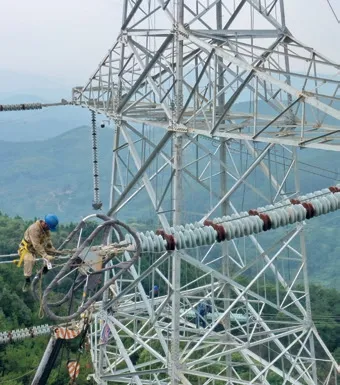Rising to the Top
2022-09-20ChinaleadingcompaniesridehighamidheadwindsByZhangShasha
China’s leading companies ride high amid headwinds By Zhang Shasha
The newest list of Top 500 Chinese enterprises, jointly unveiled by the China Enterprise Confederation (CEC) and the China Enterprise Directors Association on September 6, showed the entrants staged remarkable growth in 2021 amid an increasingly complex international environment compounded by the COVID-19 pandemic.
The companies’ operating revenue hit 102.48 trillion yuan ($14.8 trillion) in 2021, up 14.08 percent over the previous year. Their combined assets amounted to 372.53 trillion yuan ($53.45 trillion), a year-on-year increase of 8.43 percent.
Last year, the operating revenue of 244 firms,22 more than in 2020, exceeded 100 billion yuan($14.35 billion), and that of 12 companies topped 1 trillion yuan ($143.5 billion). The operating revenue threshold for a company to make the Top 500 list rose to 44.63 billion yuan ($6.41 billion), an increase of 5.39 billion yuan ($774.24 million).
“Chinese large enterprises have become more competitive than before on the international stage,” Zhu Hongren, Executive Vice President of the CEC, said at a press conference.
Growing strength
Chinese companies have been moving forward from quantitative growth to high-quality development according to the list. Compared with previous years, this year more than half of the Top 10 companies are engaged in the real economy.
The State Grid Corp. ranks first on the list, with an operating revenue of 2.97 trillion yuan ($426.73 billion) in 2021, followed by the China National Petroleum Corp., the China Petrochemical Corp. and China State Construction. The Sinochem Group, for the first time, is among the top 10, at the ninth spot, and the China Railway Engineering Group Ltd. is in the 10th position. The other top 10 names are banks and insurance companies.
The equipment manufacturing industry is the largest source of entrants on the list, while companies in the strategic emerging industries, in particular,occupy more spots. “The list speaks volumes for China’s emphasis on the real economy,” Li Jin, a researcher with the Chinese Institute of Business Administration, told. “The gap between non-financial firms and financial firms has narrowed.”
Over the past decade, a number of companies in traditional industries such as chemical engineering, metallurgy and real estate have exited the Top 500 list, and members of these industries that remain on the list are speeding up in upgrading their business. Meanwhile, more companies in strategic emerging industries including modern high-end equipment manufacturing, financial services,Internet and information technology services, logistics and supply chain have been included.

Workers from the State Grid Corp. build power networks in Zhangzhou, Fujian Province,on July 29
Specifically, this year’s list includes seven companies in the wind power and photovoltaic equipment manufacturing industry, seven in Internet services, three in power and energy storage, one in culture and entertainment, and one in education services.
“It shows China’s adjustments to its economic structure and the economic layout are paying off,” Li said. “The Top 500 enterprises are major drivers of China’s social and economic development, making great contributions to economic output, tax revenue growth as well as industrial security.”
Research and development (R&D) have been high on these enterprises’ agenda. In 2021, their R&D input amounted to 1.45 trillion yuan ($208 billion), which had grown 1.67 times since 2012 and accounted for 51.95 percent of the national total in the year.
Their R&D intensity, the ratio of a firm’s R&D investment to its revenue, reached 1.81 percent in 2021 from 1.33 percent 10 years ago. It has climbed for five consecutive years, to what is now a record high.
The R&D intensity has increased significantly in communications equipment manufacturing,aerospace, as well as semiconductor, integrated circuit and panel manufacturing industries. That of Huawei, ZTE, China Aerospace Science and Technology Corp., China Information Communication Technologies Group Corp. and China Aerospace Science and Industry Corp. surpassed 10 percent in 2021.
Last year, the Top 500 companies held 672,900 valid invention patents, which was 4.01 times more than that a decade ago and accounted for 35.3 percent of the total. The firms were also active in participating in formulating industrial standards.
“Tracing back, the world economic center has moved several times, and behind each new center is always the power of innovation,” Zhu said. He added that China has gained worldwide attention with its achievements in high-speed railway,nuclear power, shipbuilding, space, quantum computing and 5G technologies.
The operating revenue of China’s Top 500 companies amounted to 97.74 percent that of the U.S.Top 500 in 2021
Competitive edge
In the 10 years since 2012, the combined operating revenue of the Top 500 Chinese companies had more than doubled from 50.02 trillion yuan($7.18 trillion) to exceed the 100-trillion-yuan mark for the first time as of 2021.
Their net profits attributable to parent companies had also improved from 2.17 trillion yuan($311.77 billion) to 4.46 trillion yuan ($640.77 billion) over the same period.
In terms of operating revenue, 16 companies from the Chinese mainland ranked first globally in their respective industries in 2021.
According to Zhu, the operating revenue of China’s Top 500 companies amounted to 97.74 percent that of the U.S. Top 500 in 2021. Their total assets reached 106.46 percent of that of their U.S. counterparts, overtaking the U.S. companies for the second consecutive year.
Despite the progress, Zhu said the number of China’s world-class enterprises that can pioneer global technological and industrial development is still insufficient. Compared with the global leaders, Chinese companies still lag behind in science and technology competence, profitability,innovation capacity and brand influence.
The world is undergoing profound changes unseen in a century, with the pandemic, shifts in the international landscape and the ongoing technological revolution bringing in opportunities as well as challenges for Chinese enterprises, according to Zhu.
“Large enterprises should be international,instead of restraining themselves in domestic development,” he said, further suggesting Chinese companies sell their goods and services to overseas markets, and more importantly, to make R&D and production initiatives in the international markets, strengthening their global competitiveness through innovation. BR
